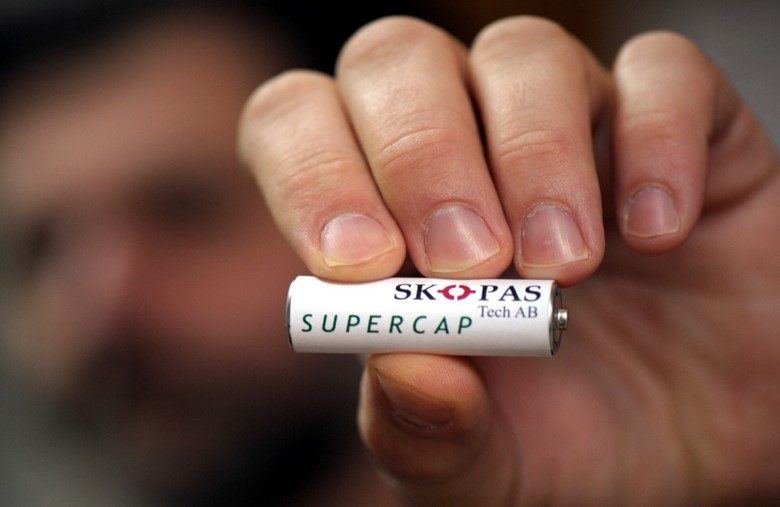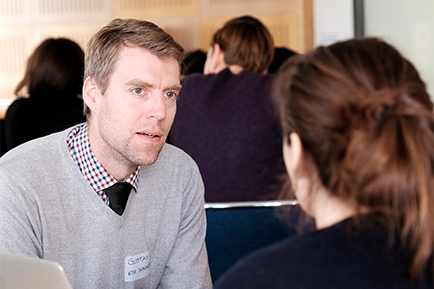The future of green batteries in development at KTH

Imagine a future where batteries can be made from biomaterials, be charged within seconds, and are so clean they can simply be tossed in the trash when they reach the end of their lifespan. This is the technology currently in development at KTH by researchers Natalia Skorodumova and Igor Pasti.
Every year, hundreds of millions of batteries are sold worldwide. Most are not recycled. By using carbon made from natural, bio-based materials in a new generation of batteries, so called hybrid electrochemical capacitors, KTH spinoff SKOPAS develops energy storage solutions that are both green and clean. Their batteries will use no materials that are rare or toxic, like lithium, but will simply put be made of only water with a little bit of salt and carbon, in a biodegradable shell. In the future, this kind of battery could be used in for example wireless payment solutions that need to be charged very quickly, or to store energy from solar cells in your home.
- Together, we have put in almost twenty years of fundamental research on energy storage and conversion materials, says Natalia Skorodumova, Professor at the ITM School. We felt we had started to understand quite a lot about these materials and how they could be used in reality and we thought “why not try to bring it out to society”.
Fully charged in seconds
Apart from being more sustainable than traditional batteries, supercapacitators have the advantage of charging way quicker, in only a few seconds. They don’t include lithium, which has been known to explode, meaning they will be safer to use. However, a standard supercapacitator only has around twenty percent of the energy intensity of a lithium battery, meaning you would have to charge it five times as often.
- Our original thought was to use our technology in mobile devices, but because of the lower energy density, the device would have had to be too big to be portable. That’s why we decided to go for a hybrid solution, where we combine a traditional battery with a capacitator. That way we more than tripled the energy density of conventional supercapacitors.
Asking the right questions
Almost two years ago, Natalia Skorodumova and Igor Pasti found their Business Development Coach Daniel Carlsson on KTH Innovation’s website.
- Daniel has really helped us a lot, says Natalia Skorodumova. When someone asks you the right questions, you start formulating your thoughts in a new way. We are still tweaking our technology, but by talking to Daniel and to potential customers we have learned a lot about where we should put our focus.
A new standard
Right now, the team focuses on developing prototypes, amongst others an alternative to the traditional AA battery, in the same shape and size. After completing several tests, the team is aiming at testing their samples with real customers. But there’s still a lot of work left before you can buy a SKOPAS battery in a supermarket.
- In five years, we hope to have initial production established, have signed our first customers, and have secured some fraction of the market, says Natalia Skorodumova. Of course, with a bigger team and more resources we could move faster, so that’s something we’re also working on.
A nourishing cycle of research and commercialization
Natalia Skorodumova is dividing her time between her research in the role as a Professor at KTH, and developing SKOPAS. Can it be hard to keep the two separate?
- Actually, it separates quite nicely, since we would never go as far as to develop working prototypes and run user tests in our research, says Natalia Skorodumova. When you’ve reached a result and published your paper, you move on. What is interesting here is how many new problems we have encountered by going further. We have formulated so many fundamental questions that we didn’t think about before, so it’s actually a really nourishing cycle.
"Fun, challenging, and interesting"
During the past two years, the SKOPAS team have been very active together with KTH Innovation. They have gotten business development coaching, talked to KTH Innovation’s legal counsel and patent attorney, joined the internationalization program Brighter in Munich, gone through the KTH Innovation pre-incubator program, and gotten feedback from over 250 experts in the Innovation Panel.
- If you’re a researcher at KTH, my advice is to go to KTH Innovation and try. You never know before you start whether you’ll like it or not, but personally I think it’s fun, challenging and interesting. You don’t have to become an entrepreneur, but try to get your technology out there. It’s exciting to bring something new out from the lab and to make it useful in society.
Natalia Skorodumova on:
The KTH Innovation pre-incubator program: The program was a very good introduction into the world of entrepreneurship, which was new to us. Read more about the program here. Apply by February 12th!
The KTH Innovation Brighter Program: Very useful visit to Munchen, with many interesting meetings, useful coaching, which put our ideas in an international perspective Read more about the KTH Innovation Brighter Program
The Innovation Panel: We got massive positive feedback with many useful tips and connections.
The support in general: Very useful!
Find out more about SKOPAS
Find out more about SKOPAS here.


